Social engagement definition
Social media engagement is the process of communicating (engaging) with an online community and measuring the effectiveness of your activity across every social media platform.
These conversations can take place on individual social media platforms such as Twitter, Facebook, and LinkedIn, or in blogs, forums, and third-party review sites.
A strong social media engagement strategy allows businesses to remain in constant contact with their customers by advancing brand interests and responding to feedback in a seamless cycle.
But it’s also important because social is a key channel for acquiring new customers; it’s often where their first impressions happen.
Free eBook: How to listen, adapt, and design the experiences customers want next
Social media engagement metrics
While engagement can mean engaging directly with customers, in marketing, we tend to use the term ‘social media engagement’ to mean the measure of engagement your posts receive.
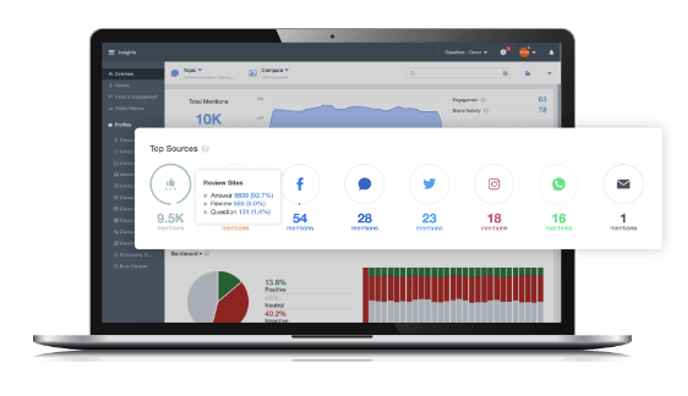
Brand tracking social media engagement will be looking at a range of metrics that show how well your posts are landing, how much interaction they receive from customers, and the overall sentiment being exhibited as a result.
Across all channels, that usually means looking at social media engagement metrics like:
- Likes
- Retweets
- Shares
- Replies
- Comments
- Mentions
- Link clicks
- Influencer reach
- Impressions, etc.
So when you’re tracking social media engagement, you’ll really be keeping an eye on two things:
- How effective your social media marketing is
- The overall effect those views and interactions are having on your brand’s reputation
Why is social media engagement important?
Conversations regarding your organisation, your industry, and your interests are constantly occurring online, whether or not you choose to participate.
Only once you join a conversation can you affect its direction and its outcome. The use of social engagement tools, along with a sound strategy and strong messaging, allows you to interact with your audience and shape the conversation surrounding your brand or product.
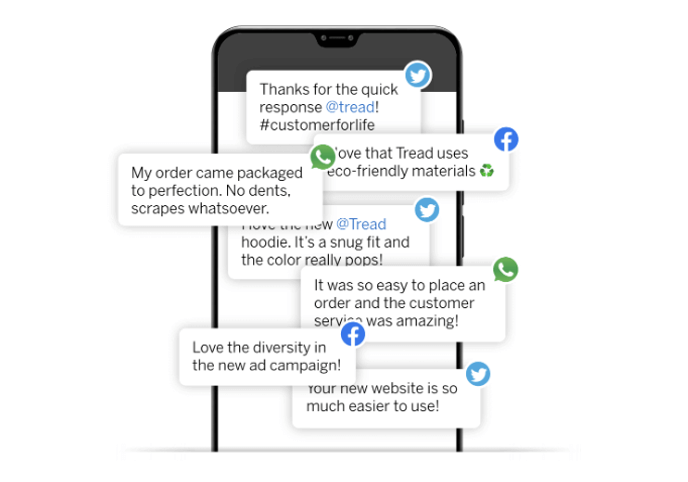
Social media is fast becoming the dominant method for communication across the world, creating both a need for active response and an opportunity for brand sentiment improvement.
What’s the ROI of social engagement?
Calculating ROI is a case of connecting profit to investment, but that becomes tricky when we’re talking about social media engagement because – short of tracking a campaign URL on a paid asset – it’s often next to impossible to trace interactions on social media directly to purchases.
So when talking about the ROI of social media, a smart first step is to look at industry-proven statistics about what could be lost if you don’t put a strong focus on boosting your social media efforts.
Ok, so what do we know? Well, we know that when companies engage and respond to customer service requests over social media, those customers end up spending 20% to 40% more money with the company. And that 83% of people use Instagram to discover new products.
We also know that 63% of consumers think brands should do a better job of listening to them and that social media is now most people’s first choice for customer care. Twitter research even shows that 71% of users expect brands to respond within one hour, pointing to a natural business case for being more responsive and agile on the biggest social media platforms.
Beyond all that, though, there are things to monitor that can give you a strong idea of how your investment in social media posts and activity is paying off.
Share of voice is a great way to look at ROI. Share of voice on social media sites is a read on how much of the conversation you’re winning when it comes to the conversations and interactions your target audience is having and exposed to. The higher your share of voice, the more likely you are to be front of mind in metrics like brand recall.
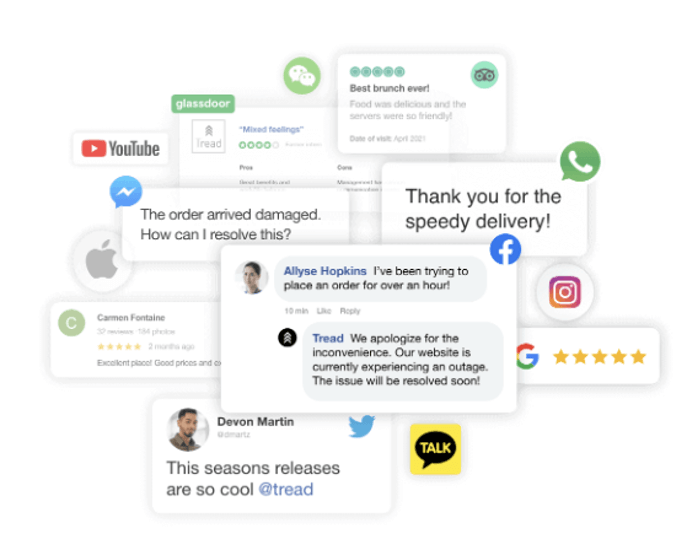
You can also look at general trends over time. For instance, if your organisation adopts a social strategy that helps you massively improve engagement, and then you see sales improve alongside it, that’s a trend that’s easy to spot. …But there’s also a risk of confusing correlation with causation there, because social is just one part of holistic customer journeys.
For example, if your sales rise, your brand recognition will too – and people might naturally begin to follow your social accounts as a result. That’s a correlation, rather than causation.
The solution here lies in software that can track how your core social media metrics are changing over time, and pinpoint wins. That’s something we’ll come onto shortly. But first: how can you actually drive those positive changes and boost social media engagement in the first place?
How to boost engagement on social media
Generating buzz on your social media platforms and driving engagement requires consistent effort over time.
There’s no magic bullet to boosting engagement, but there are tried and tested methods you can put into practice that will, if followed with regularity and patience, have a positive influence on your social media presence. Here’s how to form the basis of your social media strategy:
Listen and respond
People are talking about and to you on every social media platform – are you listening? The brands that win on social are the ones who use the right social listening tools and proactively respond to every single comment that comes their way. And even the ones that don’t.
That means helping people who have issues as much as it does identifying conversations that are happening in your industry and adding your input. It means being where your customers are – on all social platforms – and ensuring they feel heard, as well as being able to become a proactive voice on industry topics.
Your social listening software should, at the very least, be able to pick out these opportunities for you, but the really smart tools can use natural language processing to determine the sentiment, emotion, and intent of every conversation and flag whether a customer experience support agent needs to step in and escalate. It will also help you to pick up on wider trends too and uncover systematic issues that require more than 1:1 intervention.
Some brands find it useful to break their social media marketing out as a separate entity from their customer support efforts by creating dedicated social media accounts for help queries. This won’t necessarily be the best solution for every brand, but it can help in keeping responses to issues separate from social media marketing efforts.
Be consistent
Consistency in effort is one thing, but on social, you also need to think about consistency in tone of voice, and consistency in output.
Your brand’s tone of voice should shine through in every tweet, post, photo, and reply, to the point where your target audience should instantly be able to spot your activity from anyone else’s, across all social platforms.
As for consistency in output, striking a regular cadence is key. Around your ad hoc responses to customer messages, you should ideally have a content calendar in place with a regular drumbeat of organic content that keeps the conversation going, and keeps your brand in people’s feeds (and minds).
It’s also a great idea to pair that content calendar with one full of national and global events. With that, you can spot opportunities to preemptively create assets that can ride on the coattails of conversations you know will be happening – like sports events, for example. But it’ll also ensure you don’t make any big social media faux pas by accidentally making big announcements that’ll fly under the radar or seem insensitive.
Be useful
If you’re using social media platforms chiefly as a way to further your brand messaging and awareness, it’s worth remembering that that’s a pretty selfish pursuit – and ask yourself, honestly, why anyone would follow you. You need to give before you can take, which is why really any successful social media engagement strategy will revolve around being useful.
Being useful in this space means bringing benefits to your followers or subscribers. It means looking outward rather than inward and sharing content that isn’t just about you and your products. Brands should absolutely use social media to talk about their offering, but think of it like meeting a friend for coffee: if you only spoke about yourself, they’d probably want to leave, right?
So seek to provide benefit on social platforms by thinking about what your audience is looking for and working to provide it for them – all the while peppering your messaging alongside that benefit-driven content. And remember: sometimes just being entertaining provides a benefit.
Track what works
Social media engagement is more science than art. Getting it right means having a firm grasp of what’s working and what isn’t, and constantly tweaking your content formula to match your findings. If one particular type of content gets more engagement than any other, it’s worth your time to try and understand why.
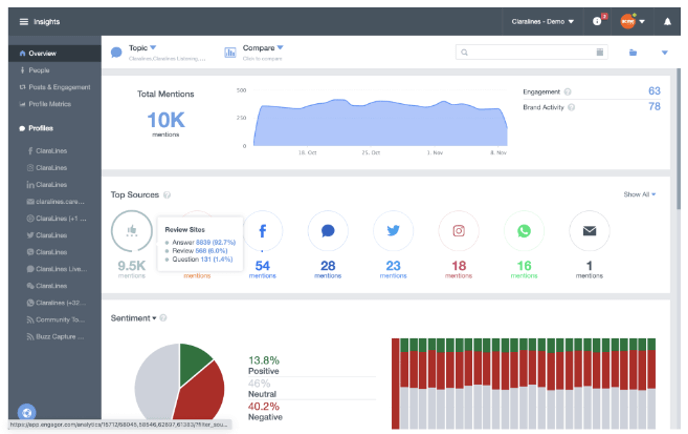
Use a ‘test and learn’ philosophy here; replicate the format of successful posts but change some parameters to test various hypotheses. Does video work better than still images, for instance? Or does posing a question generate more engagement than presenting a statement?
Social listening and analytics suites can help here, which is what we’ll talk about in the next section…
How can you measure social media engagement?
An effective social engagement strategy is driven by social listening and analysis, which can be conducted through a social analytics tool like the Qualtrics XM platform. In fact, there are lots of social media analytics tools available out there, but there are some key elements to look out for when deciding on which tool to use.
Here’s everything you should look for in a tool for measuring social media engagement:
Analysis of multiple social media channels
If your social media analytics tool can’t listen to all the social media accounts you’re running, it won’t provide you with a full picture of your social media presence, including underlying trends and sentiment. Audience behaviour may vary from channel to channel, for instance, so you need to be able to bring everything into one centralised analytics tool.
Dashboards and visualisation
The most important part of collecting and monitoring any data is being able to act on what you learn. Data visualisation that shows insights you can work at a glance will be your best weapon here. Your social media analytics tool needs to represent the data it analyses in a way that teams across your business can easily understand.
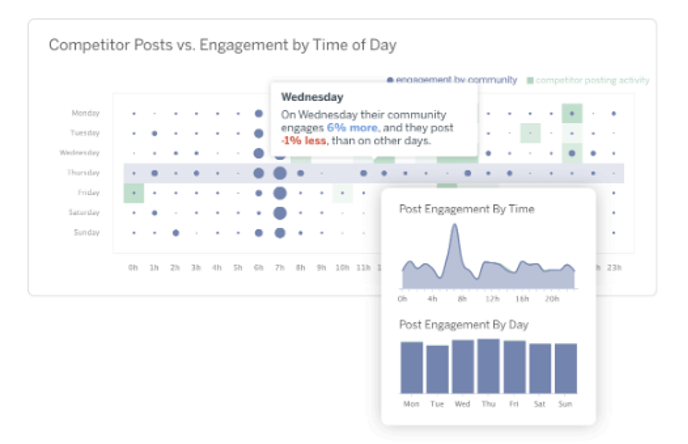
Sentiment analysis
Sentiment analysis can help you understand how your audience demographics really feel about your brand. Social media analytics tools with natural language understanding and machine learning built-in can identify the relationships between your social media activity and customers’ prior or subsequent behaviour, meaning you can gather critical insights about the customer journey.
Emotion Analysis and Effort Scoring
Effort scoring – how difficult it is to do business with you – capabilities provide businesses with a leading indicator of customer loyalty and churn. Scoring emotions against any given experience will help highlight experience gaps that you can work to close. This is especially useful in terms of social media engagement, where people can be really effusive about their positive or negative experiences with a brand – you need to be able to capture all of them.
Segmented data
Identifying how your customers feel about and interact with your brands can guide social media strategy, but it’s always worth getting a deeper understanding of how those opinions vary by age, location, gender, and other areas of audience segmentation.
Operational data
We mentioned that calculating ROI in social can be tricky, but the right tool can demystify that link for you by pulling in your own operational data to show you how your social data relates to metrics like sales, web traffic, and more.
Bringing everything together
Qualtrics can help with all of the above and more, with a complete solution for monitoring, measuring, and driving social media engagement. Our social media analytics tools can find everything written about you – on every social media platform – and pinpoint the root causes of conversations and suggest actionable insights. That’s a crucial part of the puzzle, as social media plays a huge role in the overall CX experience.
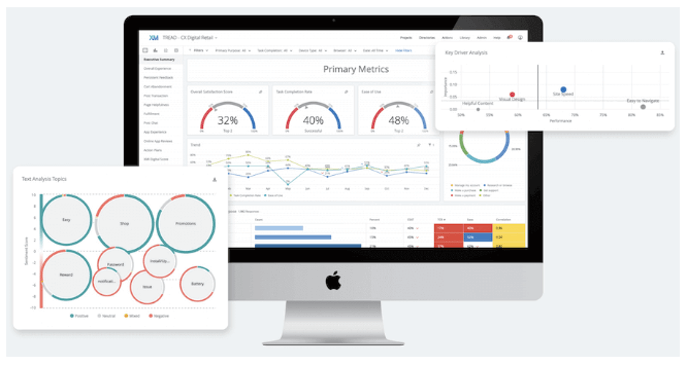
With Qualtrics XM, you’ll know what social media channels your customers are using, what they’re saying, and how you can and should react. We can be the hub of your efforts to increase social media engagement.
Free eBook: How to listen, adapt, and design the experiences customers want next